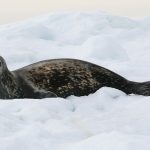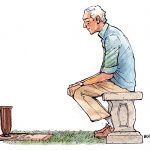
And a shared passion for the outdoors
By Tom Bryant
Jim Dean passed away peacefully in his sleep right before last Thanksgiving. I wrote this column a couple of years after he retired from his job as editor of Wildlife in North Carolina. The piece was to appear in an outdoor-related supplement to Business North Carolina. The supplement never ran, and I’ve held the story until now. Jim was my good friend and fellow sportsman.
“Let’s see, Tom, favorite trip. Man, that’s going to be hard. There’ve been hundreds of ‘em.” Jim was standing in front of his antique oak filing cabinet when I asked him to tell me about what he thought was his favorite adventure.
“But there was one.”
He hesitated and his eyes glowed as he began talking in a low voice. You could hear the longing for those old friends and the excitement of the trip.
“It was 1970 and my first time fishing out west. We did it right, Henry’s Fork on the Snake River. A. J. Johnson, his son, Alvin, and Reid Bahnson were with me. I remember it like yesterday. I prayed for days before the trip that if the plane had to crash, it would crash on the way home, not on the way out there. You know, I still remember the price of that plane ticket; and ironically, it cost more then than it does now, $742 round trip. The last time I flew out to Yellowstone, the fare was around $500 or so.
“What a time we had. We’d fish till 10:00 in the evening and be back at ‘em by 5:30 the next morning. We were indeed fortunate because during the 10 days that we were there, the Feds opened Lewis River in Yellowstone Park for fishing. We motored in on the Madison River and then rowed for miles up the shallow Lewis to catch fish like never before.”
Jim was indeed in the heart of trout territory. The Madison provides some of the finest fishing for wild rainbow and large brown trout in the country. And the Lewis River that flows south out of Lewis Lake into the Snake also has trout in abundance. I can only imagine the fish that were caught on a fly-fishing adventure of a lifetime.
Jim Dean and I go way back. We both broke into the newspaper business at the same property, The Times-News in Burlington. Jim later moved to Raleigh, and after a time, took over the helm of Wildlife in North Carolina. During his tenure with the magazine, he also became famous for his articles in such magazines as Field & Stream, Sports Afield, and Gray’s Sporting Journal.
We were in Jim’s den, which any outdoorsman would give his last bamboo rod to own, reminiscing. “I was real lucky when I started at the Times-News,” Jim said. “Bill Hunter hired me and I couldn’t even type.”
In those days, the newspaper industry was famous for its writers. Most were individuals who had their own little idiosyncrasies, to say the least, and Bill Hunter fit the mold.
“My first assignment was to cover, I think for a Sunday paper, a girls’ softball team. It took me all morning to write a 6-inch story. In the meantime, Bill had put together a feature, two pages of sports, wrote the heads and sent them up to composing without proofing. He was the consummate professional, and I was indeed lucky to work for him. But you know, Tom, that whole paper was full of pros. Howard White, the editor, what a prince. You see that old filing cabinet over there? That piece came out of the Times-News. There was a bank of them against a wall, and in a modernization effort, the paper bought all new metal cabinets. Howard asked the staff if anyone wanted to buy one. I think I made 80 dollars a week when I signed on, and it took about every cent from week to week. Although back then, you could buy a week’s groceries for $20.00; but man, I wanted that cabinet. I asked Howard if I could pay for it in a week or so, and he said take it on home.
“That was a different era. Howard; Jim Lasley; Conner Jones; Bill Hunter; Essie Norwood, the society editor; the composing room, remember that crowd? Reading lead type produced on linotype machines upside down and backwards. You know, Tom, I can remember those days easier than I can remember last week.”
I watched as Jim got up to make another cup of coffee.
“I’ve had a great life,” he said over his shoulder. “I’ve always seemed to be in the right place at the right time.”
Jim Dean had a varied and exciting life. He was born at Fort Oglethorpe, Georgia in 1940. His father, William Dean was from Roanoke Rapids; and his mother, Margaret Geneva Brown Dean, was from Woodland, North Carolina. Jim lived at West Point as a youngster while his father, a West Point graduate, taught math there until he went overseas in 1943.
Jim graduated from Roanoke Rapids High School and received a B.A. in English from the Virginia Military Institute. He then attended the University of North Carolina as a special student in journalism.
“You know, while I was at Carolina, I gained what was the equivalent of a journalism degree in a couple of semesters. I don’t believe they have that program any longer.”
Early on, Jim joined the army and was stationed at the Pentagon in Washington and later at Ft. Holabird in Baltimore. It was while he was stationed in Baltimore that the fly-fishing bug bit and he began writing about his experiences.
“My hero was Joe Brooks, the fishing editor of Outdoor Life,” Jim said as he sat back down with a full cup of coffee. “I’ve probably read everything that gentleman has written.”
“When I was 20 years old, I called Joe and told him that I was interested in outdoor writing and wondered if he could give me some advice on how to get started. He invited me to his house!
“I spent the day with that gentleman, and he opened a lot of doors for me. He taught me a ton, and I kept up with him for years.”
All this experience worked for Jim. When he was named editor of Wildlife in North Carolina in 1978, he wrote regularly for the publication, collaborating with associate editor Larry Earley to produce a book titled Wildlife in North Carolina, which featured articles, photographs and artwork published during the magazine’s 50-year history. In 1995, UNC Press also published a collection of his “Our Natural Heritage” columns titled Dogs that Point, Fish That Bite. In 2000, Jim also published The Secret Lives of Fishermen, a second collection of columns.
Jim has been a regular contributor to various outdoor magazines. In 2001 he was named contributing editor to Field & Stream where he wrote a regular bimonthly column entitled “Out There.”
“Tom, I’ve learned a lot about writing for these magazines. When I got started, not many people were doing what I aspired to do and that was to be a regular writer for a national publication. With the help of my old buddy Joe from Outdoor Life, I soon figured out that most magazine editors live on the edge of desperation. They are looking for a story to fill space. It doesn’t have to be artsy, just good. And if the editor asks for 2500 words, give him 2500 words, not 2600. And better yet, give him art! I became an accomplished photographer pretty early in my career. If you send an editor a complete package, edit plus photos and it’s halfway good, he’ll use it. Come on back here and check out my office.”
Jim’s office was outfitted just like you would expect. Old girly calendars from the ‘60s hung on the walls.
“I got these calendars out of A.J. Johnson’s country store up in the mountains.” Jim said. “They were hanging in my cabin up on Wilson’s creek, but I moved them down here when I gave up that place.”
Fly-fishing reels were all over the table, and Jim told me that they were for his trip coming up in a week or so. “Some of my old buddies from out west are going to meet me in Belize and we’re going to do a little bone fishing.”
Jim also has a cabin on the family farm close to Oxford. I read about it in several of his columns in Wildlife in North Carolina.
“Real primitive,” Jim said. “No running water or electricity, for that matter; but there is an old cast-iron wood cook stove that will put these modern inventions to shame. The farm is about 400 acres with a couple of good bass ponds. I used to bird hunt regularly; but like everywhere else, the quail have disappeared.”
Along with his skills as a writer, Jim also is an accomplished painter, using watercolors as his medium. He also carves duck decoys that would rival the early masters.
We walked back into the kitchen and I asked Jim about a photograph that was on the counter. It was of a pretty girl smiling into the camera as if she knew a secret about the photographer.
“That’s my daughter, Susan. Believe it or not, she has two children. She looks like a child herself. Susan lives up in Evington, Virginia. I also have a son, Scott, who lives in Dayton, Ohio. He graduated from North Carolina State and is a meteorologist.” The pride that every father has for his children was evident as Jim talked.
“These kids have meant everything to me. We’re great friends.”
“Tommy, I’ve been real lucky and have had a super life. Good friends, a great family, and the time to do what I love, and that’s to enjoy the great outdoors.”
I packed up my stuff, and we headed out on the back deck overlooking a carport that housed an old Bronco from the ‘70s, a four-wheel drive SUV, and a wrapped-up Harley Davidson motorcycle.
“I love my Harley,” Jim laughed. “I think I surprised everybody when I bought that thing. Call it my late life crisis. I think I’ll take it out for a spin this afternoon.”
As we were saying our good-byes, I asked Jim about his upcoming trip to Belize.
“I’ve never been down there, and I can’t wait to try out the bone fishing. We’re also going after permit. It’s gonna be a great time.”
And in perfect form, he ended our visit in true Jim Dean style.
“I also plan on hanging around in a hammock under those palm trees and drinking something cool and tall with one of those little umbrellas sticking out the top.” PS
Tom Bryant, a Southern Pines resident, is a lifelong outdoorsman and PineStraw’s Sporting Life columnist.





